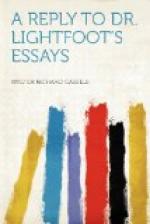V.
MELITO OF SARDIS—CLAUDIUS APOLLINARIS—POLYCRATES.
Throughout the whole of these essays, Dr. Lightfoot has shown the most complete misapprehension of the purpose for which the examination of the evidence regarding the Gospels in early writings was undertaken in Supernatural Religion, and consequently he naturally misunderstands and misrepresents its argument from first to last. This becomes increasingly evident when we come to writers, whom he fancifully denominates: “the later school of St. John.” He evidently considers that he is producing a very destructive effect, when he demonstrates from the writings, genuine or spurious, of such men as Melito of Sardis, Claudius Apollinaris and Polycrates of Ephesus, or from much more than suspected documents like the Martyrdom of Polycarp, that towards the last quarter of the second century they were acquainted with the doctrines of Christianity and, as he infers, derived them from our four Gospels. He really seems incapable of discriminating between a denial that there is clear and palpable evidence of the existence and authorship of these particular Gospels, and denial that they actually existed at all. I do not suppose that there is any critic, past or present, who doubts that our four Gospels had been composed and were in wide circulation during this period of the second century. It is a very different matter to examine what absolute testimony there is regarding the origin, authenticity, and trustworthiness of these documents, as records of miracles and witnesses for the reality of Divine Revelation.
I cannot accuse myself of having misled Dr. Lightfoot on this point by any obscurity in the statement of my object, but, as he and other apologists have carefully ignored it, and systematically warped my argument, either by accident or design, I venture to quote a few sentences from Supernatural Religion, both to justify myself and to restore the discussion to its proper lines.
In winding up the first part of the work, which was principally concerned with the antecedent credibility of miracles, I said:—
“Now it is apparent that the evidence for miracles requires to embrace two distinct points: the reality of the alleged facts, and the accuracy of the inference that the phenomena were produced by supernatural agency ... In order, however, to render our conclusion complete, it remains for us to see whether, as affirmed, there be any special evidence regarding the alleged facts entitling the Gospel miracles to exceptional attention. If, instead of being clear, direct, the undoubted testimony of known eye-witnesses free from superstition and capable, through adequate knowledge, rightly to estimate the alleged phenomena, we find that the actual accounts have none of these qualifications, the final decision with regard to miracles and the reality of Divine Revelation will be easy and conclusive.” [130:1]
Before commencing the examination of the evidence for the Gospels, I was careful to state the principles upon which I considered it right to proceed. I said:




